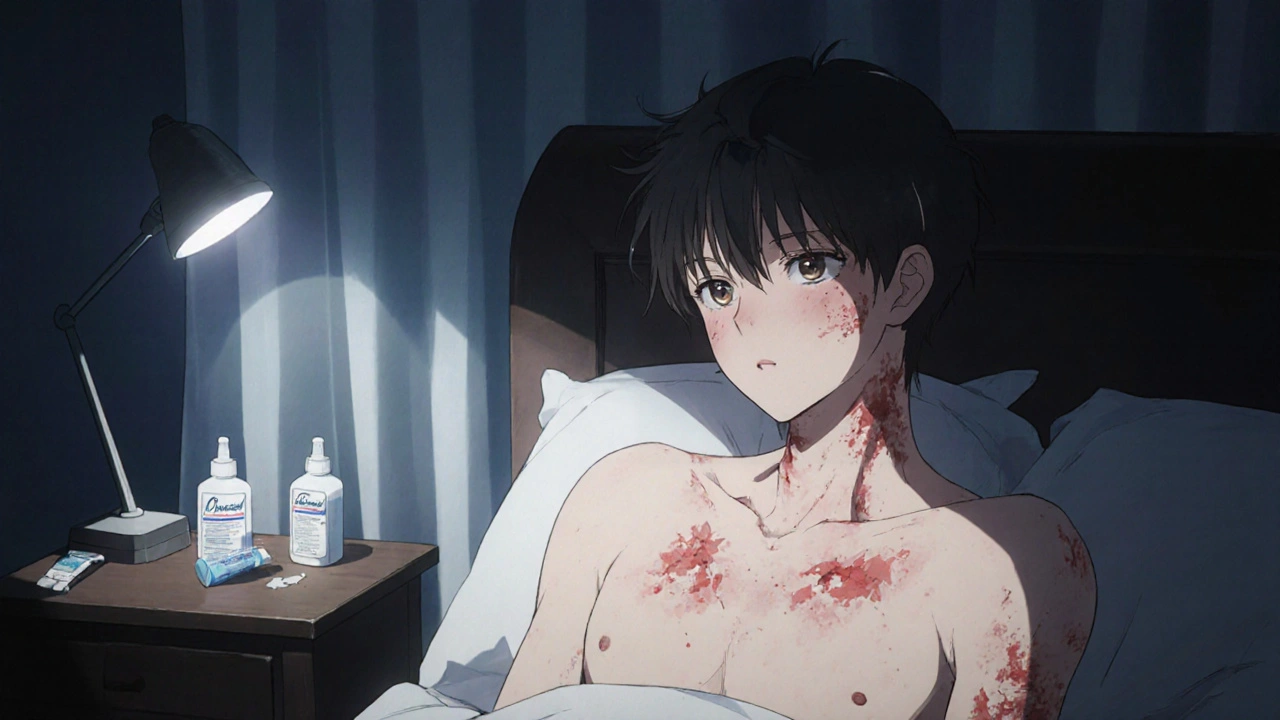If you’ve been using a steroid cream like desonide for weeks or months to calm eczema, psoriasis, or a stubborn rash-and now your skin is burning, red, and flaring worse than before-you’re not alone. Many people report this exact pattern: the cream works at first, then stops working, and when you stop using it, your skin goes into overdrive. This isn’t just a bad reaction. It’s called topical steroid withdrawal, and desonide is one of the most common triggers.
What Is Desonide?
Desonide is a low-potency corticosteroid cream or ointment, usually prescribed for mild to moderate skin inflammation. It’s often recommended for sensitive areas like the face, eyelids, or groin because it’s less harsh than stronger steroids like clobetasol or betamethasone. Doctors see it as a safe option for kids and long-term use-until it isn’t.
Desonide works by suppressing the immune response in the skin. That means less redness, itching, and swelling. But your skin doesn’t know it’s supposed to be temporary. Over time, it starts to rely on the drug to stay calm. When you stop, your body doesn’t know how to regulate itself anymore. That’s when the rebound effect kicks in.
What Is Topical Steroid Withdrawal?
Topical steroid withdrawal (TSW) is a condition that happens after stopping long-term use of topical corticosteroids. It’s not officially recognized by every medical association, but thousands of patients report the same symptoms: severe redness, burning, itching, peeling, swelling, and even nerve pain. Some describe it like a sunburn that won’t heal. Others say their skin feels raw, hot, or like it’s crawling.
Research from the National Institutes of Health shows that TSW can last from months to years. A 2023 study in the Journal of the American Academy of Dermatology tracked 127 patients who stopped using topical steroids after using them for over six months. Nearly 80% experienced withdrawal symptoms within two weeks, and 40% still had moderate to severe symptoms after one year.
Desonide isn’t the only steroid linked to this, but it’s one of the most frequently reported. Why? Because it’s so commonly prescribed for chronic conditions like atopic dermatitis. People use it daily for months, sometimes years, thinking it’s harmless. They don’t realize the risk builds silently.
Why Desonide Can Cause Withdrawal
It’s not about strength alone. Even low-potency steroids like desonide can cause dependence if used too often or too long. The skin’s natural barrier gets weakened. Blood vessels dilate and stay dilated. The body’s own cortisol production drops because it’s been told to shut down by the external steroid.
Here’s what happens step by step:
- You apply desonide daily to a flare-up. Within days, the redness fades.
- You stop using it. The rash comes back, maybe worse.
- You start again. It works again.
- You repeat this cycle. Over time, you need to use it more often or in larger amounts.
- Eventually, you can’t stop. If you do, your skin explodes into inflammation.
This isn’t addiction in the drug sense-it’s physiological dependence. Your skin has lost its ability to self-regulate. And when you pull the plug, your body doesn’t know how to reboot.
Who’s Most at Risk?
Anyone using topical steroids for more than two weeks straight is at some risk. But certain groups are more likely to develop TSW:
- Parents applying steroid creams daily to babies or toddlers with eczema
- Adults with chronic facial dermatitis who use desonide to hide redness
- People who buy steroid creams online without a prescription
- Those who use steroid creams on large areas of skin or under occlusion (like plastic wrap)
Women between 25 and 45 are the most commonly reported group in patient forums, often because they’re managing eczema or rosacea and have been told by doctors that desonide is safe for long-term use. Many didn’t know the risks until their skin started falling apart.

Symptoms of Desonide Withdrawal
Withdrawal symptoms can show up within days or weeks after stopping. They often get worse before they get better. Common signs include:
- Intense burning or stinging (even without visible rash)
- Widespread redness that spreads beyond the original area
- Flaking, peeling, or oozing skin
- Swelling in the face, hands, or eyelids
- Hair loss or thinning in treated areas
- Sleep disruption from constant itching or pain
- Emotional distress, anxiety, or depression due to appearance changes
Some people report feeling feverish or having flu-like symptoms. Others describe their skin as "on fire" or "like it’s being scraped raw." These aren’t exaggerations-they’re real physiological reactions.
What to Do If You Suspect Withdrawal
If you’ve been using desonide regularly and now your skin is reacting badly after stopping, don’t panic-but don’t restart the cream either. Restarting might feel like relief, but it traps you in the cycle.
Here’s what actually helps:
- Stop all topical steroids, including desonide. No exceptions.
- Use gentle, fragrance-free moisturizers. Look for ceramides, squalane, or colloidal oatmeal.
- Avoid hot showers, harsh soaps, and scrubbing. Pat skin dry.
- Wear loose, cotton clothing. Synthetic fabrics can irritate sensitive skin.
- Track your symptoms in a journal. Note what triggers flares and what helps.
- See a dermatologist who understands TSW. Not all do. Ask if they’ve treated patients with steroid withdrawal before.
Some people find relief with cool compresses, antihistamines for itching, or low-dose doxycycline to reduce inflammation. But there’s no magic pill. Healing takes time-often 6 to 18 months.
How to Prevent Desonide-Related Withdrawal
The best way to avoid TSW is to use desonide the way it was meant to be used: short-term, sparingly, and under supervision.
- Use it only for active flares, not daily maintenance.
- Limit use to 1-2 weeks at a time. If it’s not better in two weeks, see your doctor.
- Never apply it to large areas unless directed.
- Don’t use it on the face longer than 7 days unless your doctor says otherwise.
- Ask about non-steroid alternatives like tacrolimus or pimecrolimus for chronic conditions.
Many dermatologists now recommend a "steroid ladder"-start with the weakest possible steroid, use it for the shortest time, and switch to non-steroid options as soon as possible.

Real Stories, Real Consequences
One woman from Ohio used desonide on her face for three years to control redness she thought was rosacea. When she finally stopped, her skin turned bright red and swollen. She lost her job because she couldn’t go outside. It took 14 months for her skin to heal enough to wear makeup again.
A father in Texas applied desonide to his 18-month-old daughter’s eczema every day for 18 months. When he stopped, her entire body erupted. He spent two years learning how to care for her skin without steroids. He now runs a support group for other parents.
These aren’t rare cases. Online communities like Topical Steroid Withdrawal Support have over 100,000 members. Most joined after being misinformed that desonide was "safe for long-term use."
What Doctors Are Saying Now
Medical opinions are shifting. In 2024, the British Association of Dermatologists updated its guidelines to include a warning about TSW, even with low-potency steroids like desonide. They now advise doctors to:
- Warn patients about the risk of rebound before prescribing
- Set clear stop dates for steroid use
- Offer non-steroid alternatives upfront for chronic conditions
- Refer patients to specialists if withdrawal symptoms appear
Still, many doctors don’t bring it up. Patients are left to find answers on their own.
What’s Next for Desonide Users?
If you’re using desonide today, ask yourself: Why am I using it? Is it helping, or am I just trying to keep the flare-down? Are you using it because your skin needs it-or because you’re afraid of what happens if you don’t?
You don’t have to suffer in silence. Healing from topical steroid withdrawal is slow, but it’s possible. Many people get their skin back. It takes patience, support, and sometimes professional help.
Start by talking to a dermatologist who knows about TSW. Look for clinics that specialize in eczema or immune-related skin conditions. Join a support group. Read patient stories. You’re not broken. Your skin isn’t failing you. It’s just been overworked-and it’s asking for a break.
Can desonide cause topical steroid withdrawal even if used for only a few weeks?
Yes. While withdrawal is more common after months of use, some people report symptoms after just 2-4 weeks of daily application, especially on sensitive skin like the face or genitals. The risk increases with frequency, area covered, and occlusion (like covering with bandages).
Is desonide safer than other steroid creams?
Desonide is classified as a low-potency steroid, so it’s less likely to cause side effects than stronger ones like clobetasol. But that doesn’t make it safe for long-term use. All topical steroids carry the same risk of dependence and withdrawal with prolonged use. The difference is speed-not safety.
Can I use moisturizers while withdrawing from desonide?
Yes, and you should. Moisturizers help repair the skin barrier. Use fragrance-free, simple formulas with ingredients like ceramides, hyaluronic acid, or squalane. Avoid anything with alcohol, essential oils, or dyes. Many people find relief with plain petroleum jelly or colloidal oatmeal creams.
How long does topical steroid withdrawal last after stopping desonide?
It varies. Most people experience symptoms for 6 to 18 months. Some recover in 3 months; others take 2-3 years. The length depends on how long you used the steroid, how often, and how much skin was affected. Healing isn’t linear-there will be good days and bad days. Patience is critical.
Should I go cold turkey off desonide or taper off slowly?
Most experts recommend stopping completely rather than tapering. Tapering can prolong the process and delay healing. Cold turkey is harder at first, but it gives your skin a clean reset. Work with a knowledgeable doctor to manage symptoms during the first few weeks.







Liam Dunne
November 16, 2025 AT 15:14Been there. Used desonide on my face for 8 months thinking it was harmless. Stopped cold turkey and my skin looked like a lobster that got thrown in a furnace. Took 14 months to heal. No magic fix, just time, plain petroleum jelly, and avoiding everything that even smelled like chemicals. Now I don’t touch steroids unless I’m dying-and even then, I’m skeptical.
Philip Rindom
November 17, 2025 AT 15:26Bro, this is why I stopped trusting doctors who say ‘it’s low-potency so it’s fine.’ My mom used it on my eczema every day since I was 5. By 22, my face was raw and I couldn’t wear sunglasses without crying. I’m 28 now and still getting flares. They don’t warn you because they don’t want to admit they’ve been pushing this stuff for decades like it’s vitamin C.
Jess Redfearn
November 19, 2025 AT 09:57so like… if i stop using it, my skin just explodes? like, no kidding? that’s wild.
Sharon Campbell
November 21, 2025 AT 05:22lol i read this and thought ‘another anti-steroid fear post’ but then i saw the nihs study and the 80% thing. okay maybe they’re not just crazy. still, i’m not quitting my cream. i’ve got a wedding in 3 weeks.
Patrick Merk
November 22, 2025 AT 11:08There’s something deeply unsettling about how easily we’ve normalized chemical suppression of natural biological processes. We treat skin like a broken machine that needs a constant tune-up, rather than a living, breathing organ that’s been trained to beg for its own destruction. Desonide isn’t the villain-it’s the symptom of a medical culture that favors quick fixes over healing. The real tragedy? Most people don’t even realize they’ve been conditioned.
sara styles
November 22, 2025 AT 11:39And don’t even get me started on how Big Pharma and the AMA are covering this up. Desonide is just the tip of the iceberg. The FDA has known about TSW since the 90s but kept it buried because steroids are a billion-dollar industry. You think your dermatologist doesn’t know? They do. They just don’t care because they’re paid to prescribe, not to educate. I’ve got 17 research papers saved on this. They’re all suppressed. The system is rigged. You’re not broken-you’re being exploited.
Brendan Peterson
November 23, 2025 AT 18:35Interesting that the JAAD study had such a high retention rate. I’ve seen a few cases in clinic where patients didn’t realize they were dependent until they tried to stop. The emotional toll is massive-depression, social isolation, body dysmorphia. Most of them come in after their primary care doc told them ‘just keep using it.’ We need better patient education. And yes, non-steroid options like crisaborole or dupilumab should be frontline, not last-resort.
Ashley B
November 24, 2025 AT 08:18Of course this is happening. The government, the FDA, the pharmaceutical companies-they all want you addicted to creams so you keep buying them. Desonide is a gateway drug. Next thing you know, you’re on immunosuppressants, then biologics, then you’re on a feeding tube because your gut’s destroyed from all the inflammation. They’re turning healthy people into lifelong patients. It’s not medicine. It’s a control system. And you’re all just sheep walking into the slaughterhouse with a moisturizer in hand.